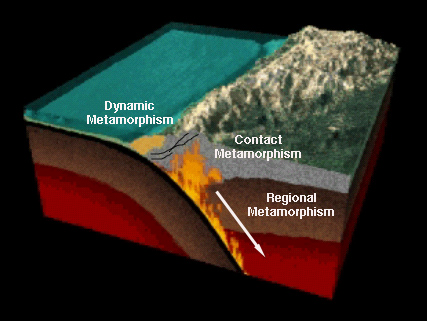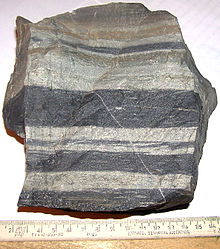This video explains the metamorphic process, you should watch it before you read this page.
The Formation of Metamorphic Rocks
| Metamorphic rocks are created by the physical or chemical alteration by heat and pressure of an existing igneous or sedimentary material into a denser form. Due to the action of plate tectonics, compression, stress and shearing forces over long periods of time, rocks can be essentially warped and deformed, causing them to be compacted into a smaller volume of space. As a consequence, metamorphic rocks are always more dense than their original material, and also much less susceptible to erosional breakdown. As the Earth's plates move over geologic time, a plate containing igneous or sedimentary rock may become subducted under another plate. The sheer weight of the material above it can cause the rock to undergo metamorphism. In some cases, heat from the Earth's interior can melt the rock slightly. Examples of metamorphic rocks are schist (converted basalt), quartzite (compressed sandstone), and marble (compressed limestone or dolomite). |

Dynamic Metamorphism
Above is a diagram of the formation of metamorphic rocks. There is three different kinds of Metamorphisms going on.
The first is the Dynamic Metamorphism, and it occurs in fault zones when country rock is ground up and partially recrystallized. Rocks formed by dynamic metamorphism display a sugary texture, moderate foliated texture and small rock fragments within the foliation. An example of this is soapstone, pictured below.

Contact Metamorphism
The second type of metamorphic formation is, Contact Metamorphism, it's the name given to the changes that take place when magma is injected into the surrounding solid rock it occurs when country rock is exposed to high heat. Proximity to magma produces Contact Metamorphism. These rocks do not have a foliated texture. The best example of this rock is a Hornfel, a layered rock, with its main ingredients sandstone, shale, slate, and limestone. The Hornfel is pictured below.

Regional Metamorphism
The third and final Metamorphic rock formation is Regional Metamorphism, is the name given to changes in great masses of rock over a wide area. Rocks can be metamorphosed simply by being at great depths below the Earth's surface, subjected to high temperatures and the great pressure caused by the immense weight of the rock layers above. Much of the lower continental crust is metamorphic, except for recent igneous intrusions. Horizontal tectonic movements such as the collision of continents create orogenic belts, and cause high temperatures, pressures and deformation in the rocks along these belts. If the metamorphosed rocks are later uplifted and exposed by erosion, they may occur in long belts or other large areas at the surface. The process of metamorphism may have destroyed the original features that could have revealed the rock's previous history. Recrystalization of the rock will destroy the textures and fossils present in sedimentary rocks. A few types of Regional minerals include marble, and gneiss.
Gneiss rocks are formed from pre-existing formations that were igneous or sedimentary.
Marble s a non-foliated metamorphic rock composed of recrystallized carbonate minerals, most commonly calcite or dolomite.
Click on the pictures below to learn more about them!
Where are Metamorphic Rocks found?
This is a good website to visit if your looking to learn more about metamorphic rocks!
Thanks for viewing the metamorphic rocks page. Don't forget to check out the sedimentary rock page once your done!